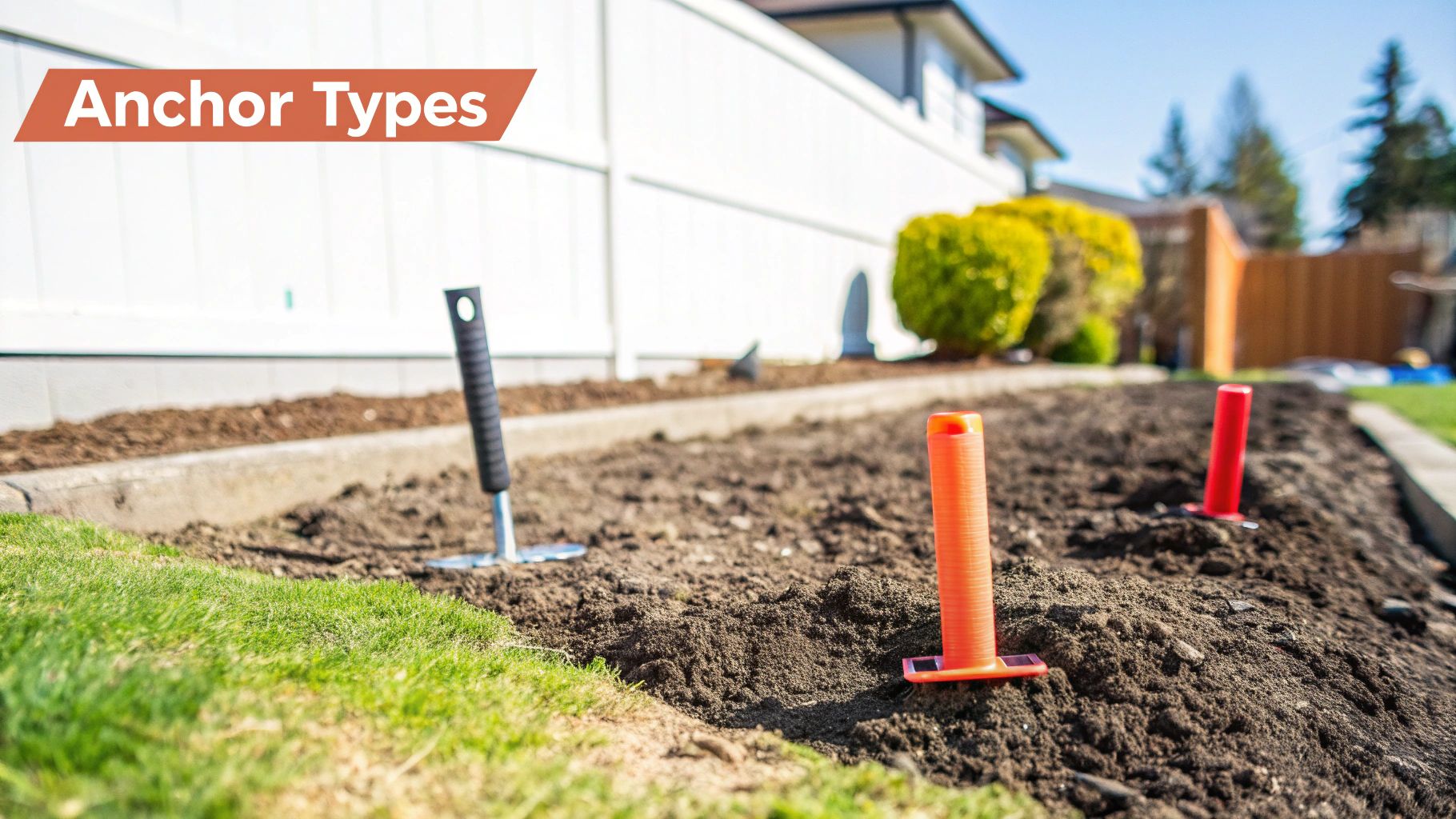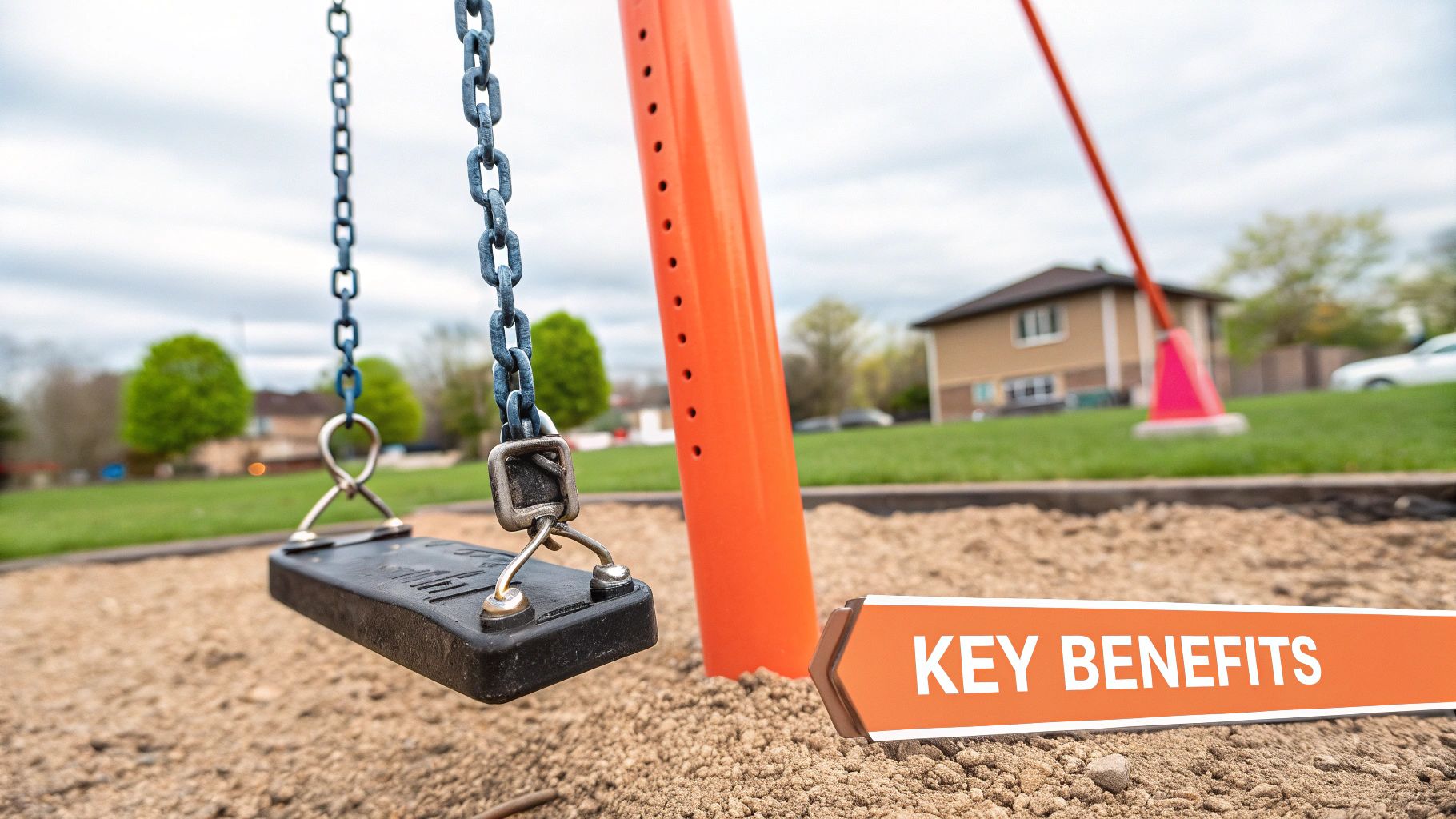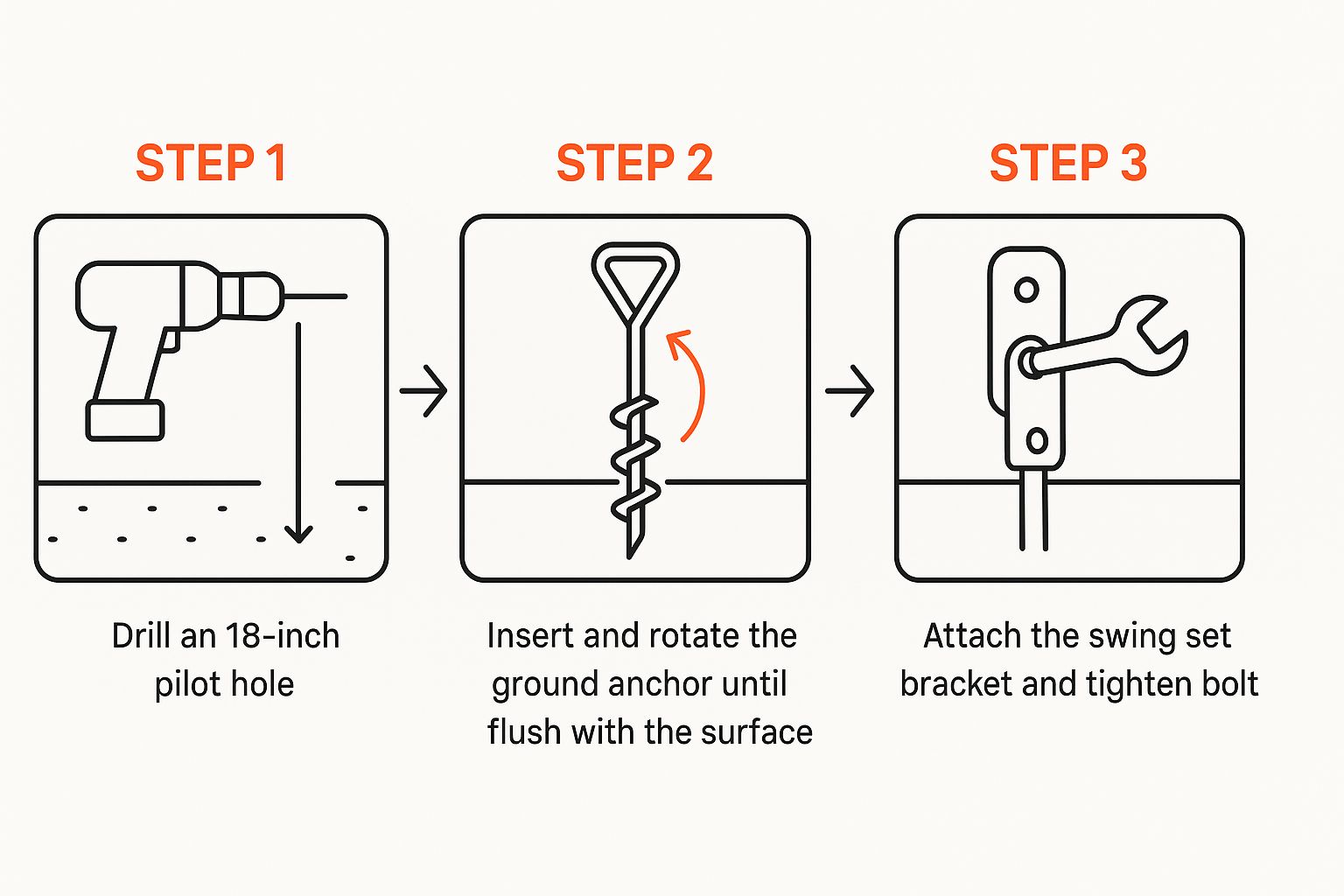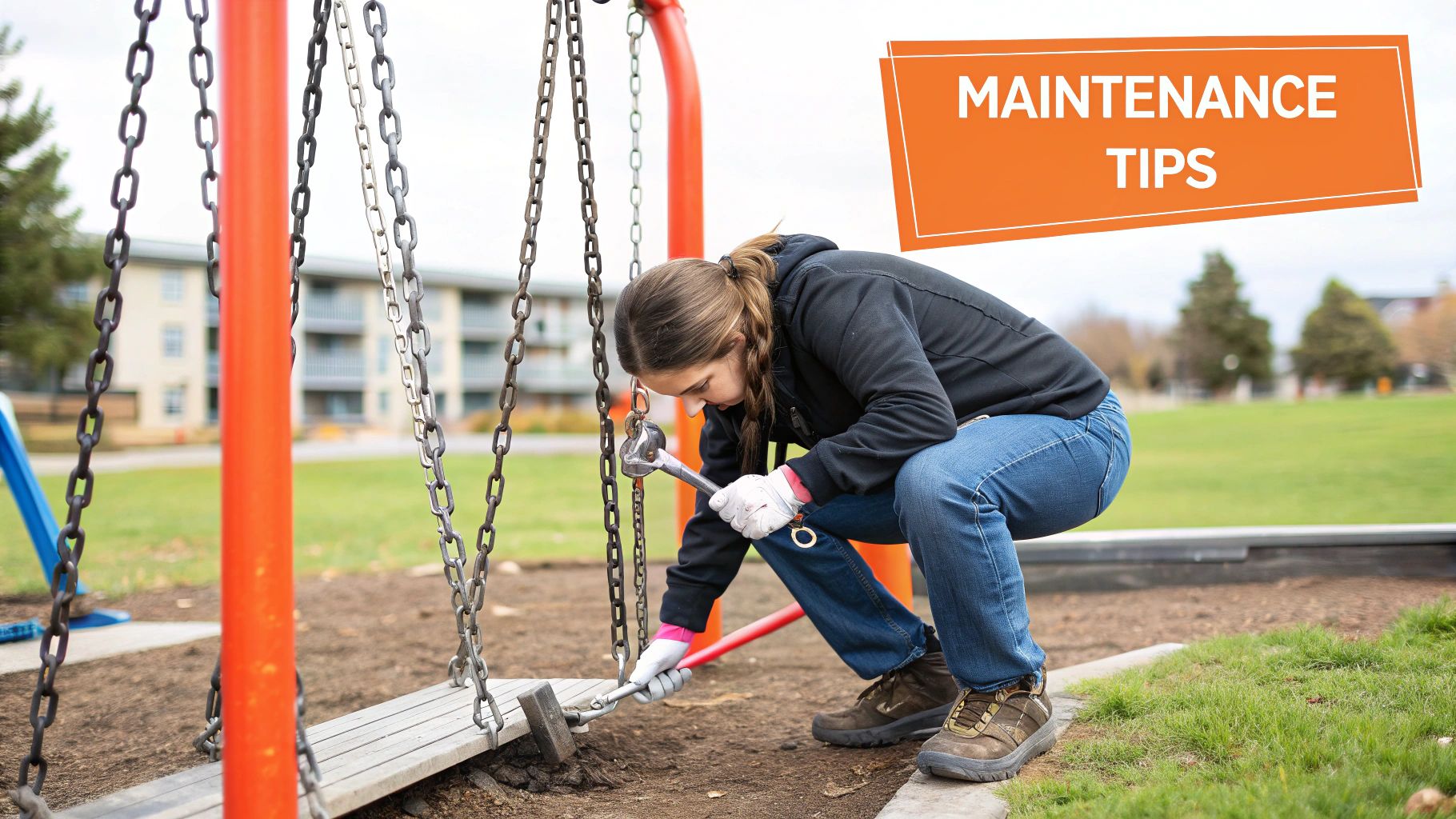-
CALL US:
- (866) 952-3456
Even the heaviest, most solid-looking swing set can move. That's why swing set ground anchors are an absolute must-have for safety. These aren't just accessories; they are essential pieces of hardware that bolt the playset's legs securely into the ground, stopping it from lifting, shifting, or tipping over when the kids are having a blast.
Think of it this way: without anchors, your swing set is just sitting on top of the grass. With anchors, it becomes a part of your yard.
It's easy to underestimate the forces at play here. When a child gets a good swing going, they generate a surprising amount of momentum and lift. Now, add another child swinging, maybe even in the opposite direction. The frame gets pulled and pushed from multiple angles at once.
Even the most robust swing set will start to wobble under that kind of stress. This is where a lot of parents get a false sense of security. A little wobble doesn't seem like a big deal, right? But most backyards have subtle slopes you might not even notice.
On even a slight incline, that wobble can quickly turn into a real hazard. The swing set’s weight shifts downhill, making it much easier for the uphill legs to lift right off the ground. Over weeks and months, this constant rocking and shifting can also cause the legs to dig into the ground unevenly, putting stress on the joints and weakening the entire structure.
This is exactly what swing set ground anchors are designed to prevent. They lock the frame to the earth, directly countering those lifting forces.
Key Takeaway: Anchors do more than prevent a catastrophic tip-over. They stop the small, daily movements that slowly compromise a swing set's stability and shorten its lifespan.
You've got a few options when it comes to anchors, and the right choice really depends on your soil and how permanent you want the installation to be.
Making the right choice here is your first step toward a truly safe setup. The emphasis on safety isn't just a trend; it's a growing standard. In fact, the global swing set market hit USD 365.34 million in 2023 and continues to grow, driven by parents demanding safer play equipment. You can see the full breakdown of this growth in this detailed market report.
Ultimately, taking the time to install anchors is one of the most important things you can do as a playset owner. For a deeper dive into all the ways you can make your backyard safer, take a look at our guide on overall swing set safety. A little bit of effort up front provides a whole lot of peace of mind.

I’ve seen it happen time and time again: what works perfectly for your neighbor’s swing set could be a total disaster in your own backyard. Choosing the right swing set ground anchors isn't a one-size-fits-all job. It’s a decision that hinges on your specific yard conditions and the playset you've chosen. Get this right from the start, and you're building a foundation of safety that will last for years.
Making the right choice now saves you from major headaches later and keeps that playset stable through countless hours of fun. It’s a crucial step, especially as more families invest in backyard play. The global swing set market was valued at over USD 343 million back in 2021, and its continued growth shows just how much parents value safe home play areas. You can see more on these trends and their impact on safety standards in these insights on outdoor play equipment from Grand View Research.
The most critical factor, without a doubt, is your soil. An anchor that holds like a rock in dense clay will pull right out of loose, sandy ground. The first thing you should do is take a few minutes to get to know your dirt.
Auger-Style Anchors: These are the real workhorses for most backyards. Their corkscrew design is brilliant for grabbing hold in normal loam, packed dirt, and even soil that's on the softer side. As you twist them in, they push soil out of the way and compact it, creating an incredibly tight grip.
Spike Anchors: Think of these as super-sized, heavy-duty nails. They really shine in hard, compacted soil or ground with lots of small rocks where trying to twist an auger would be a frustrating, fruitless exercise. They’re fast to install, but be warned—they don't have the same holding power as augers in softer ground.
Concrete-In Anchors: For absolute, rock-solid stability, this is the way to go. If you're dealing with very loose, sandy soil or rocky ground where other anchors just can't get a grip, concrete is your best friend. You’re essentially creating your own unmovable foundation for the playset.
My Pro Tip: Still not sure about your soil? Grab a shovel and dig a small test hole about a foot deep. If the dirt is loose and just crumbles in your hand, you should lean toward auger or concrete anchors. If it's dense and you have to fight to get the shovel in, spikes are probably a good bet.
The playset itself is the next piece of the puzzle. A simple, lightweight metal A-frame set has completely different anchoring needs than a massive wooden fortress with a slide, rock wall, and clubhouse. Heavier sets generate a lot more force when kids are playing, and that force goes straight to the anchors.
For instance, a standard metal swing set is often perfectly fine with auger anchors in decent soil. But take a large wooden swing set—some of which weigh over 500 pounds before a single child climbs on—and you’re looking at a whole different level of stress on the foundation. For these big guys, I almost always recommend concrete-in anchors as the safest and most reliable choice, no matter what the soil is like.
To help you sort through the options, I've put together a quick comparison table. This should make it easier to see which anchor is the right fit for your situation.
This table breaks down the most common anchor types to help you find the best match based on your soil, your swing set, and how much work you're willing to put in.
| Anchor Type | Best For Soil Type | Recommended Swing Set | Installation Method | Pros & Cons |
|---|---|---|---|---|
| Auger | Loam, Packed Dirt | Lightweight Metal or Small Wood | Twists into the ground with a bar or wrench. | Pros: Great holding power in most common soils. Cons: Can be difficult in rocky or very hard ground. |
| Spike | Hard, Compacted, Rocky Soil | Lightweight Metal or Small Wood | Driven into the ground with a sledgehammer. | Pros: Very easy and fast to install. Cons: Less holding power in soft or loose soil. |
| Concrete-In | All Types (Especially Loose/Sandy) | Heavy Wood or Large Metal | Set into a poured concrete footing. | Pros: The most secure and stable option available. Cons: High-effort installation; permanent. |
By taking the time to match the anchor to both your soil and your swing set, you can build a backyard playground that's ready for years of safe, worry-free fun. It might seem like a small detail, but this careful planning turns a simple installation step into the most important safety feature of all.

A smooth installation really starts before you even think about breaking ground. Getting your tools and the site ready ahead of time is the difference between a frustrating afternoon and a secure, professional-looking result. Think of it as setting the stage for safety.
Having the right gear on hand makes all the difference. You wouldn't try to bake a cake without a mixing bowl, right? Same idea here. A little foresight now prevents those annoying mid-project runs to the hardware store.
The exact tools you'll need will depend on the anchors you picked, but here’s a rundown of the essentials that will cover most situations.
Critical Safety Step: Before a single shovel-full of dirt is moved, you absolutely must call 811. It's a free national service that gets your local utility companies to come out and mark where underground lines for gas, electric, and water are buried. Hitting one of those lines is seriously dangerous and can lead to some eye-watering repair bills.
With your tools laid out, it's time to focus on the ground. A well-prepped site is the foundation of a stable and safe playset.
First things first, find the most level spot in your yard. You can correct for minor slopes, but starting with a flat area makes the whole job much, much easier.
After you've called 811 and have the all-clear, go ahead and assemble the swing set in its final spot. Grab your tape measure and marking flags to mark the ground exactly where each anchor needs to go. This bit of careful work now is what prevents a wobbly, unstable swing set later.
Honestly, understanding site prep is a skill that comes in handy for all sorts of backyard projects. Whether you're anchoring a playset or building outdoor structures, the fundamentals of leveling and securing a foundation are the same. These are great skills to have when creating any kind of DIY backyard play area.
This focus on secure installation isn’t just for playsets. The entire anchors market, which includes heavy-duty products for major construction, was valued at a massive USD 4.6 billion in 2024 and is still growing. This trend highlights just how important safety and durability are across the board for all types of projects.
Alright, you’ve picked your spot and have your tools laid out. Now comes the most important part: securing the swing set to the ground. This is where all that prep work really pays off, transforming a wobbly frame into a safe, sturdy playset for your family.
Let's walk through how to install the two most reliable types of swing set ground anchors. Getting the technique right is everything. It prevents that slow, almost unnoticeable shifting that can weaken the whole structure over time. Whether you’re twisting in augers or pouring concrete, the end goal is the same—an unmovable base for countless hours of fun.
For most backyards with typical clay or firm soil, auger anchors are a fantastic, no-mess solution. Their corkscrew design gives them a surprisingly strong grip once they're driven deep into the ground.
First, get your fully built swing set positioned exactly where you want it to live permanently. Once you're happy with the placement, use a can of spray paint or a simple stake to mark the ground right next to the inside of each leg. This is your target for each anchor.
Now, carefully shift the swing set just enough to give yourself room to work.
A Pro Tip From Experience: If you're dealing with rock-hard, dry soil, don't fight it. Just pour a little water on each of your marks and let it soak in for a few minutes. This small step makes twisting the augers in so much easier.
Place the pointed tip of the auger on your mark and start twisting it into the earth. You can do this the old-fashioned way by sticking a strong metal bar through the eyelet for leverage, but a heavy-duty drill with the right socket adapter will save your back and get the job done in minutes.
The most important thing? Keep the auger perfectly vertical as it goes down. If it goes in at an angle, you lose a massive amount of its holding power.
Keep twisting until the eyelet or top plate of the anchor is sitting flush with the ground. You definitely don't want any part of it sticking up, as that’s a major trip hazard waiting to happen. After all the anchors are installed, slide the swing set back into its final spot, making sure the legs line up perfectly with the anchors you just set.

Finally, use the hardware that came with your kit—usually brackets, lag screws, or bolts—to connect the anchor to the swing set leg. Grab a wrench and tighten everything down until there’s absolutely no play or wiggle between the leg and the anchor plate. Give it a good shake to be sure.
If you want the ultimate in stability, especially for a large wooden playset or if your soil is sandy or loose, nothing beats concrete. It's more work, yes, but it creates a permanent, rock-solid footing that will never budge.
Start with the swing set in its final position and mark the ground for each leg. Move the set out of the way, then grab a post-hole digger. This is the best tool for the job, as it makes a nice, clean hole. You’ll want to dig a hole at each mark that's about 12-18 inches deep and roughly twice as wide as the swing set's leg.
Here’s a step many people skip: pour about 4-6 inches of gravel into the bottom of each hole. This is really important for drainage. It keeps water from pooling at the base and freezing in the winter, which can eventually crack the concrete.
Move the swing set back, carefully placing the legs into the center of the holes. This is your last chance to get it perfect, so pull out your level and check that the entire structure is level from every angle. Make any final shims or adjustments now, before the concrete goes in.
Now you're ready to mix and pour.
You're looking for a thick, oatmeal-like consistency. Too watery, and it won't be strong enough. Too dry, and it will be a nightmare to work with and won't set right.
Carefully pour your mixed concrete into each hole, filling them to just below ground level. As you fill them, grab a stick or a small trowel and poke around the leg to get rid of any trapped air pockets. Smooth the top surface with your trowel for a clean finish.
The last and most difficult step is simply waiting. You have to let the concrete cure completely, which usually takes 24 to 48 hours, depending on the mix and the weather. Do not let anyone near the swing set during this time. Any movement could ruin the bond and weaken the foundation.
Once it's fully cured, you can fill the rest of the hole with soil and sod. It's a bigger job, but the peace of mind is worth the effort. If you're tackling a big project like this, looking over a full swing set installation guide can give you a lot more context and helpful advice for the whole process.

Even with the best intentions, a few common slip-ups can compromise the safety of your entire swing set project. I’ve seen it happen time and again. Knowing what these frequent errors are ahead of time is the easiest way to ensure your swing set ground anchors provide the unshakeable stability they’re designed for. Getting it right the first time saves you from dangerous rework later on.
One of the most frequent mistakes I see is simply misjudging the soil. It's a classic case of using the wrong tool for the job. Sticking spike anchors into soft, loose dirt is a recipe for failure; they'll pull right out under the force of vigorous swinging. On the flip side, trying to twist an auger anchor into dense, rocky ground will just lead to frustration and a shallow, insecure fit.
Another critical error is not getting the anchors deep enough. An anchor that isn't fully seated just doesn't have the holding power to resist the lifting forces created by play. This is especially true for those auger-style anchors, which absolutely must be twisted in until the top plate is flush with the ground to be effective.
A surprising number of people install their anchors at a slight angle. It might not seem like a big deal, but an anchor driven in crooked loses a significant amount of its vertical holding strength. The force from swinging will pull against its weakest point, making it much easier to dislodge over time.
And when it comes to installations using concrete, impatience is the biggest enemy.
Rushing the curing process is a critical safety failure. Concrete needs a good 24 to 48 hours to reach sufficient strength. If kids use the swing set before the concrete is fully set, it can create cracks and weaknesses in the foundation, completely undermining its stability.
These simple mistakes can quickly turn a secure playset into a serious hazard. Following proper installation techniques isn't just a suggestion—it’s non-negotiable for safety. To get a complete picture of why these details are so critical, you can learn more about the established playground safety standards that guide these recommendations.
To sidestep these common issues, just keep this simple checklist in mind before and during your installation:
By actively avoiding these frequent missteps, you ensure your swing set ground anchors provide the robust, lasting security your family deserves.
Even with the best-laid plans, a few questions always pop up when you're in the middle of a project. I've been there. Let's tackle some of the most common ones I hear about swing set ground anchors so you can finish your installation with total confidence.
That really comes down to the type of anchor you chose. If you went with auger-style or those big spike anchors, you're usually in good shape. It takes some elbow grease, but you can unscrew the augers or pull the spikes out and relocate the whole playset.
On the other hand, if you set the legs in concrete footings, that's a permanent decision. Moving it would mean breaking up the concrete and a whole lot of work—frankly, it's rarely worth the effort.
Yes, one hundred percent. This is probably the most important safety question people ask. The soft layer of grass and topsoil provides next to no stability against the lifting and rocking forces your kids will generate when they're really swinging high.
Think of it this way: the real anchor point isn't the grass; it's the hard, compacted earth underneath it. The anchors are what connect your swing set's frame to that solid ground, stopping it from tipping or shifting. It's a non-negotiable step.
You might see some lightweight stakes out there for things like tents or canopies, but they are absolutely not recommended for swing sets. A swing set's back-and-forth motion creates a unique and powerful dynamic force that a simple temporary stake just can't handle safely.
For genuine safety and your own peace of mind, you need an anchor system designed specifically for this job. Your best and safest bets will always be semi-permanent solutions like augers or permanent ones like concrete.
The golden rule is to always follow the manufacturer's instructions for your specific anchor kit. But as a solid rule of thumb, here's what I've found works best:
Feeling a bit overwhelmed by getting the anchor installation just right? The pros at Assembly Smart live and breathe this stuff. They can take care of the entire setup, giving you a perfectly secure playset without any of the hassle. Get your free estimate today and let the experts handle it.